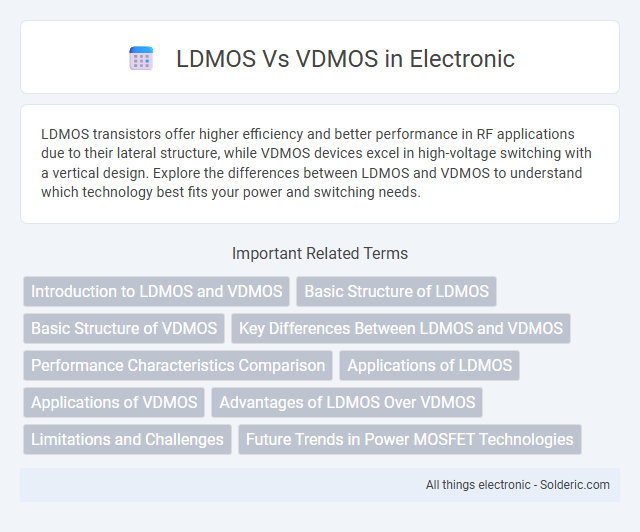LDMOS transistors offer higher efficiency and better performance in RF applications due to their lateral structure, while VDMOS devices excel in high-voltage switching with a vertical design. Explore the differences between LDMOS and VDMOS to understand which technology best fits your power and switching needs.
Comparison Table
| Feature | LDMOS (Laterally Diffused MOSFET) | VDMOS (Vertical Diffused MOSFET) |
|---|---|---|
| Structure | Laterally diffused channel | Vertical current flow |
| Application | RF power amplifiers, high-frequency switching | Power switching, high voltage applications |
| Voltage Handling | Up to ~100 V typical | Up to several kV |
| Frequency Range | High frequency (GHz range) | Lower frequency, power electronics |
| On-Resistance (Rds(on)) | Moderate, optimized for RF | Low, optimized for power efficiency |
| Switching Speed | Fast switching | Slower compared to LDMOS |
| Cost | Higher due to complex fabrication | Lower cost, simpler process |
| Thermal Performance | Good heat dissipation | Excellent due to vertical structure |
| Typical Usage Examples | Base stations, RF transmitters | Power supplies, motor drives |
Introduction to LDMOS and VDMOS
LDMOS (Lateral Diffused Metal-Oxide-Semiconductor) and VDMOS (Vertical Diffused Metal-Oxide-Semiconductor) are two key types of power MOSFETs used in high-frequency and high-power applications. LDMOS transistors are preferred for RF amplification and base station transmitters due to their superior efficiency and linearity, while VDMOS devices excel in DC-DC converters and power switching applications because of their vertical current flow and lower on-resistance. Understanding the structural and performance differences between LDMOS and VDMOS helps optimize your choice for specific power electronics designs.
Basic Structure of LDMOS
LDMOS (Laterally Diffused Metal-Oxide-Semiconductor) features a distinct basic structure characterized by a lightly doped drift region that extends laterally between the channel and the drain, enabling high-voltage operation and improved breakdown voltage. This design contrasts with VDMOS (Vertical Diffused MOS), where the current flows vertically through a heavily doped drift region, providing higher current density but typically lower breakdown voltage. Understanding the LDMOS structure can help optimize Your choice for applications requiring efficient power amplification and high-frequency performance.
Basic Structure of VDMOS
VDMOS (Vertical Double-diffused MOSFET) features a vertical structure where the current flows from the gate at the top through the N-type channel into the P-type drift region and then to the N+ drain at the bottom. This vertical design enables higher voltage handling and better current density compared to planar devices like LDMOS. Your choice between LDMOS and VDMOS will depend on the specific requirements for switching speed, voltage rating, and application efficiency.
Key Differences Between LDMOS and VDMOS
LDMOS (Lateral Diffused Metal-Oxide-Semiconductor) transistors feature a lateral structure optimized for high power and high-frequency applications, whereas VDMOS (Vertical Diffused Metal-Oxide-Semiconductor) devices have a vertical architecture suited for high voltage and high current operations. LDMOS devices exhibit lower on-resistance and higher gain at RF frequencies, making them preferred in wireless communication amplifiers, while VDMOS transistors are commonly used in power switching due to their superior avalanche energy handling and vertical current flow. The primary difference lies in their current conduction paths and fabrication techniques, influencing performance metrics like switching speed, breakdown voltage, and thermal management.
Performance Characteristics Comparison
LDMOS (Lateral Diffused Metal-Oxide-Semiconductor) transistors exhibit higher power handling capability and better thermal stability compared to VDMOS (Vertical Diffused Metal-Oxide-Semiconductor) devices, making them ideal for RF power amplification in base stations. VDMOS devices typically offer faster switching speeds and lower on-resistance, which improves efficiency in low-voltage power conversion applications. LDMOS devices advantageously maintain linearity at high frequencies, whereas VDMOS devices excel in high current density scenarios but face limitations in high-frequency linearity and thermal management.
Applications of LDMOS
LDMOS transistors are widely used in RF power amplifiers for base stations, wireless communication systems, and broadcast transmitters due to their high efficiency and linearity at microwave frequencies. Their superior breakdown voltage and robust thermal performance make them ideal for high-power and high-frequency applications compared to VDMOS devices. LDMOS technology supports advanced cellular infrastructure, including 4G and 5G networks, where reliability and power handling are critical.
Applications of VDMOS
VDMOS transistors, known for their high-speed switching and low on-resistance, are widely utilized in power management applications such as DC-DC converters, motor drivers, and power supplies. Their capability to handle high voltage levels makes them ideal for automotive electronics and industrial systems requiring efficient power control. Your choice of VDMOS devices can enhance performance in circuits demanding fast switching and energy efficiency.
Advantages of LDMOS Over VDMOS
LDMOS transistors offer higher power efficiency and greater linearity compared to VDMOS, making them ideal for RF power amplification in communication systems. Their superior thermal stability and robustness enable better performance under high-voltage and high-frequency conditions. You benefit from improved reliability and reduced signal distortion when choosing LDMOS for demanding power applications.
Limitations and Challenges
LDMOS transistors face limitations such as lower switching speeds and larger chip sizes compared to VDMOS, restricting their use in very high-frequency applications. VDMOS devices encounter challenges like increased on-resistance and more complex fabrication processes, affecting efficiency and cost-effectiveness. Your choice between LDMOS and VDMOS must consider trade-offs in performance, frequency range, and manufacturing constraints.
Future Trends in Power MOSFET Technologies
Future trends in power MOSFET technologies highlight the growing dominance of LDMOS (Laterally Diffused MOS) over VDMOS (Vertical Diffused MOS) due to LDMOS's superior high-frequency performance and robustness in RF applications. Innovations in LDMOS focus on enhancing breakdown voltage and reducing on-resistance to support 5G and electric vehicle advancements, making it a preferred choice for next-generation power electronics. Your choice of power device will increasingly favor LDMOS as it aligns better with the evolving demands for efficiency, thermal management, and scalability in modern semiconductor design.
LDMOS vs VDMOS Infographic

 solderic.com
solderic.com